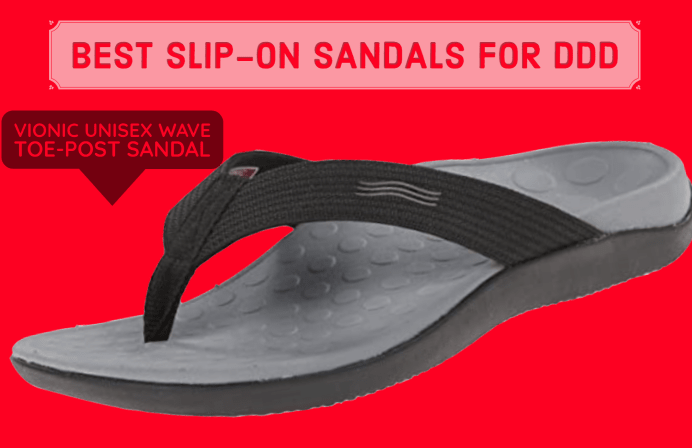Are you struggling with degenerative disc disease and looking for the best shoes to provide relief? Discover the top shoe options for optimal support and comfort in our latest blog post.
Back pain is one of the most common types of disability in Americans. According to the American Chiropractic Association, about 80% of Americans experience back pain at some point in their lives.
While there could be multiple causes of back pain the most common and misunderstood cause is Degenerative Disk Disease (DDD). There can be a variety of causes behind Degenerative Discs such as Osteoarthritis, Dysfunction in the sacroiliac joint, sciatica, and wearing inappropriately fit shoes could be one of them.
Hence, wearing properly fitted shoes can give relief from Backache. Knowledge of the significant factors that can affect your back and foot is a prerequisite for Choosing the Best shoes for Degenerative Disk Disease.
This article will help you to understand the critical factors which you must consider while you shop for shoes, as well as, will discuss in detail the Best Shoes for Degenerative Disk Disease which you can buy in 2023.
By the end of this article, you’ll be able to pick one pair of shoes that is probably the best option available for you.
Factors To Consider When Selecting Shoes for Degenerative Disk Disease or Lower Back Pain
1.) Heels: both the height and the area of the heels affect your posture and balance significantly. Make sure that the height of the heel must not more than 2″ in any case! Because high heels lean your body forward putting excessive pressure on your forefoot and lower back.
They also put your hip and spine out of proper alignment. The area of the heels should be more to distribute the body weight over the large area.
2) Avoid Flat Soles: they do not provide support to your arch. Which may cause pain in your foot, heels, ankles, knee, neck, and back. This may result in poor posture, joint and back problems, and an increased risk of falls.
3.) Arch Support: This is essential because people are born with three kinds of arches each of which needs a different kind of support. Generally speaking, choose the arch support as given below:
- Low Arch: choose straight sole shoes with motion control.
- Neutral Arch: choose shoes that will give you firm support and moderate stability.
- High Arch: Choose a shoe with good cushioning and curved sole(rocker shoes).
4) Stability: is important for proper balance which will provide you relief from back pain is a common belief. Nevertheless, researches reveal that wearing unstable shoes(rocker shoes) decreases low back pain in patients suffering from chronic back pain.
5) Cushioning: can act as a shock absorber and reduce the impact when your foot hits the ground as well as minimizes the stress that transfers to the back.
- Low Arch: Choose shoes with a firm midsole.
- High Arch/Neutral Arch: needs shoes with a soft midsole that will absorb the shock and reduce the Impact.
6) Upper Material: The upper should be flexible and resilient which allows a good degree of flexibility. It should be breathable, lightweight, and provide appropriate support to your foot.
7) Rigidity of Soles is crucial: The sole should be of the correct thickness and rigidity. Researchers have shown that Semi-rigid orthoses worn in supportive shoes can be an effective treatment of metatarsalgia.
Poron materials were found very good for adequate pressure distribution because they have the lowest rigidity, good for adequate while Neon showed the highest energy absorption.
8) Heel Counter: should be firm. Shoes with a firm heel counter will help you to get rid of the pain of arthritis. On the other hand, shoes without a firm heel counter lack stability and will support.
9) Fit: Should neither be too tight nor too loose. Your shoes should have a large toe-box to allow up and down movement of the toe.
Here are the Best Shoes for Degenerative Disk Disease (Men and Women)
Now it’s time to disclose the list of those shoes which has brought you to this article.
Best Men’s Shoes For Disk Degenerative Disease / Back Pain
We reviewed top men’s shoes for those suffering from disc degeneration or lower back pain. These shoes are also comfortable for any foot or knee conditions.
- Hoka Bondi One One 7 | Best Men’s Orthopedic Shoes
- Asics Gel-Nimbus 22 | Best Running Shoes
- New Balance Men’s 990 V5 | Best Walking Shoes
- Altra Lone Peak 4.5 | The Hiking Shoes
- Clarks Men’s Bushacre 2 | Best Dress Boots
- Bruno Marc Men’s Loafers | Top-rated Dress Shoes
Here we reviewed the listed men’s shoes one by one to guide you about likings or dislikings considering the abovementioned features.
1. Hoka Bondi One One 7 | Best Men’s Orthopedic Shoes for Lower Back Pain
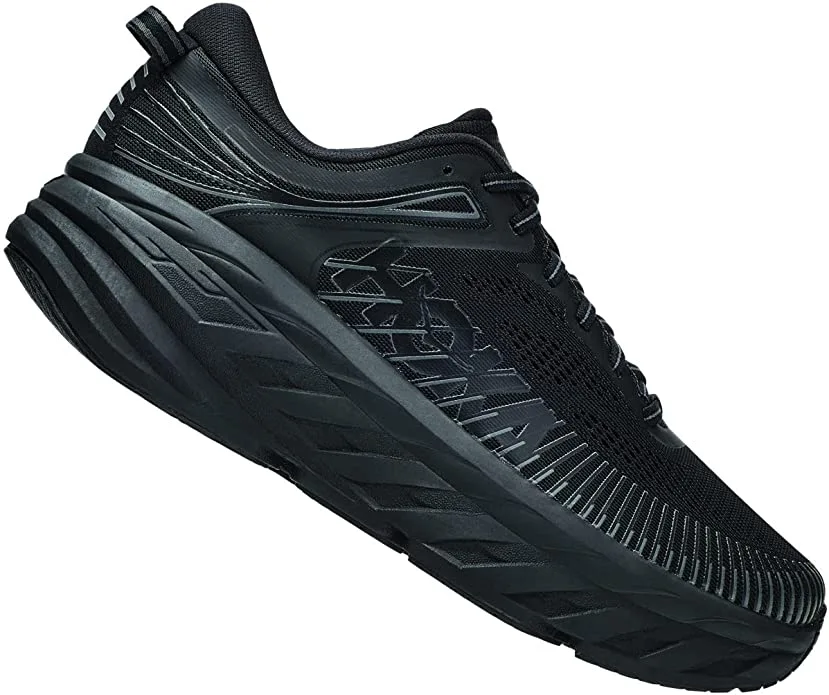
Key Features
- Nonskid slip-resistant
- Textile and synthetic upper
- Pull-on tab on heel notch
- MATRYX upper features a high-tensile synthetic fiber
- Durable full-length EVA midsole
These black beasts Hoka Bondi One One 7 are one of the most comfortable running shoes available in the market. Experience the pleasure of mind-blowing cushioning offered to you by the EVA midsole and META-ROCKER technology of the shoes.
The unmatchable comfort and protection supported by the silhouette of the shoes set them apart from their rivals and make them the best running shoes for runners or walkers struggling with disc degenerative diseases.
The shoes have incredible support making them a valuable asset for flat and neutral feet but not the best support for high-arch feet.
You will find the knitted upper of the shoes breathable and comfy that allows uninterrupted air circulation while you run with back pain, or knee or foot condition. The upper material is flexible, durable, and lightweight.
The wide forefoot and toe-box allow you to wiggle your toe up and down freely. If you want to put customized inserts, the shoes have enough room for you to do so.
The shoe has a well-constructed heel with an appropriate and firm heel counter to provide you with a smooth heel-to-toe transition, correct posture, and enough support at the back of the heel of your foot. The Rocker sole of the shoes makes off and on the movement of the shoe smooth reducing the impact on the ankle, knees, and back.
When it comes to the drawbacks, you may find the shoes squishy if you are not used to the rocker sole. And frankly speaking, the shoes look ugly. Sad but the truth!
2. Asics Gel-Nimbus 22 | Best Men’s Running Shoes for Lower Back Pain Sufferers
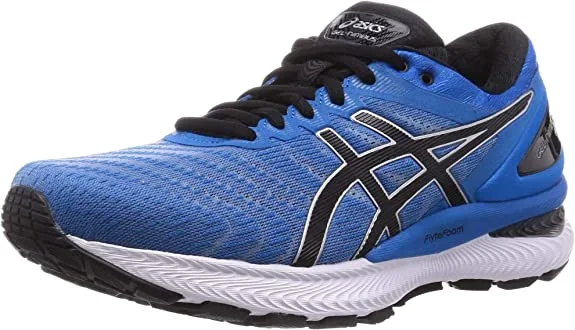
Features
- Synthetic-and-mesh
- Ethylene Vinyl Acetate sole
- Rearfoot and Forefoot GEL Technology Cushioning System
- FlyteFoam Propel Technology
- EVA Sockliner – Removable sockliner
- Guidance Line Midsole Technology
- Trusstic System technology
The great-looking Asics Men’s Gel-Nimbus 22 features Rearfoot and Forefoot GEL Technology Cushioning System that helps to reduce the impact on hitting the surface and toe-off phases providing you with tremendous support.
The subtle foot transition through the gait cycle manages to distribute the body weight evenly on the foot leveraging the comfort of your feet as well as improving the posture.
The Gel-Nimbus 22 is the lightest shoe from Asics thanks to the FlyteFoam Lyte and FlyteFoam Propel 45 technology. The foam of the shoes empowers you with supreme bounce and powerful energy return. Running in marathons will be fun with these featherweight shoes which help you to wear them to cover long distances with lower back pain.
As the shoes are loaded with the Trusstic System technology the flexibility, resilience, and structural integrity of the shoes remain conserved.
Hold your heart to read the drawbacks. Firstly, the lack of durability. According to the customers’ reviews, they have faced issues like fading of gel and deterioration of laces. The shoes aren’t good for people with wide feet as the shoes are slightly narrower at the forefoot.
3. New Balance Men’s 990 V5 | The Best Walking Shoes for Herniated Disc
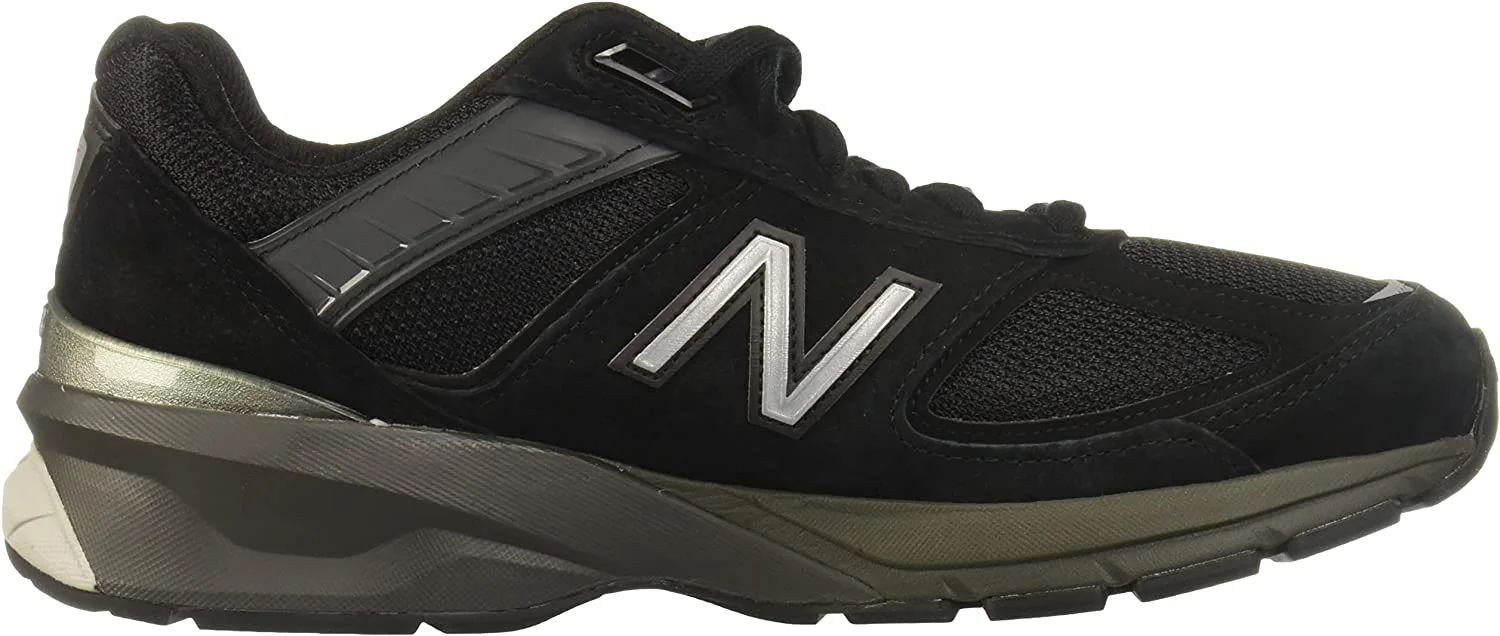
Features
- 50% Synthetic, 50% Mesh
- Made in the US
- Rubber sole
- Heritage Style: The 990v5 is an iconic sneaker
- Dual-density collar foam
- An ENCAP midsole combines lightweight foam
- Durable blown rubber outsole
I decided to put a US-made shoe on our list and I found New Balance Men’s 990 V5 to match the US standards. The shoe is insanely light and comfortable which helps you to wear them all day long. In the midsole, the shoes have ENCAP technology providing you with tremendous support and maximum durability.
You cannot compare the classic look of this pair of shoes with any ordinary walking shoe with a funky look. Feel free to wear them even as casual shoes as the shoes look great on denim too. But remember, these are walking shoes and you cannot wear them for running and if you do you might end up hurting your feet.
New Balance 990 V5 comes with moderate arch support which is even better than its previous version V4. The rubber outsole is pretty responsive and propels your foot from the ground as well as holds the ground firmly.
In case of a herniated disc or disc degeneration disease, The shoes require no break-in time and you can wear them directly bringing them out of the box. As the Upper is made of pigskin suede and mesh it looks premium but lacks breathability.
4. Altra Lone Peak 4.5 | Best Hiking Shoes for Degenerative Disk Disease
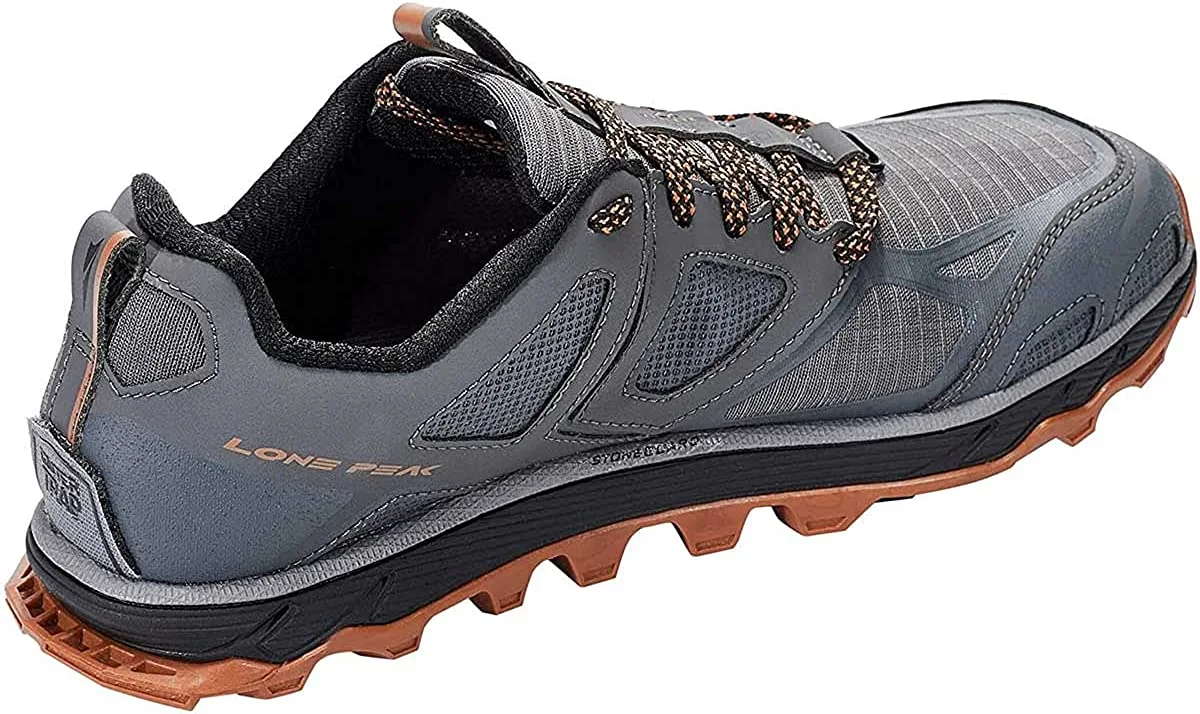
Features
- Rubber sole
- The heel measures approximately 1″
- Weight: 10.5 oz / 298 g
- Insole: 5 mm Contour Footbed
- Midsole: Dual Layer EVA / A-Bound with StoneGuard
- Outsole: MaxTrac Rubber with TrailClaw
- Cushion: Moderate
Next on the list is Altra Men’s Lone Peak 4.5 hiking shoes. The shoes are known for their Balanced Cushioning that places your heel and forefoot the same distance from the ground that reduces impact throughout your trail run. The zero-drop is much better for your legs, back, and the gait of your step.
The Foot Shaped insole with a wide toe box makes the shoes incredibly comfy that allows your toe to relax naturally and move freely. The contour along the foot leverages the fit, comfort, and support of the shoes.
The shoes also have a simplified lacing system for improved micro-adjustments.
The outsole has MaxTrac Rubber with Trail law that provides you with great traction on all kinds of even, uneven, and slick terrain.
As the shoes have a waterproof mesh upper they are super quick to dry which makes them a really good choice to wear even on beaches. They also save your feet from getting blisters. The shoes are lightweight and support hiking over long distances.
Now let’s discuss some cons, firstly they are not durable and start wearing after some time. Secondly, they do not provide proper support to people with high arches. If you have true wide feet then you might find them snug at the midfoot.
Overall Altra Lone Peak 4.5 offers enough support and comfort to run with any back disc conditions.
5. Clarks Men’s Bushacre 2 | Best Dress Boots for Back Pain Sufferers
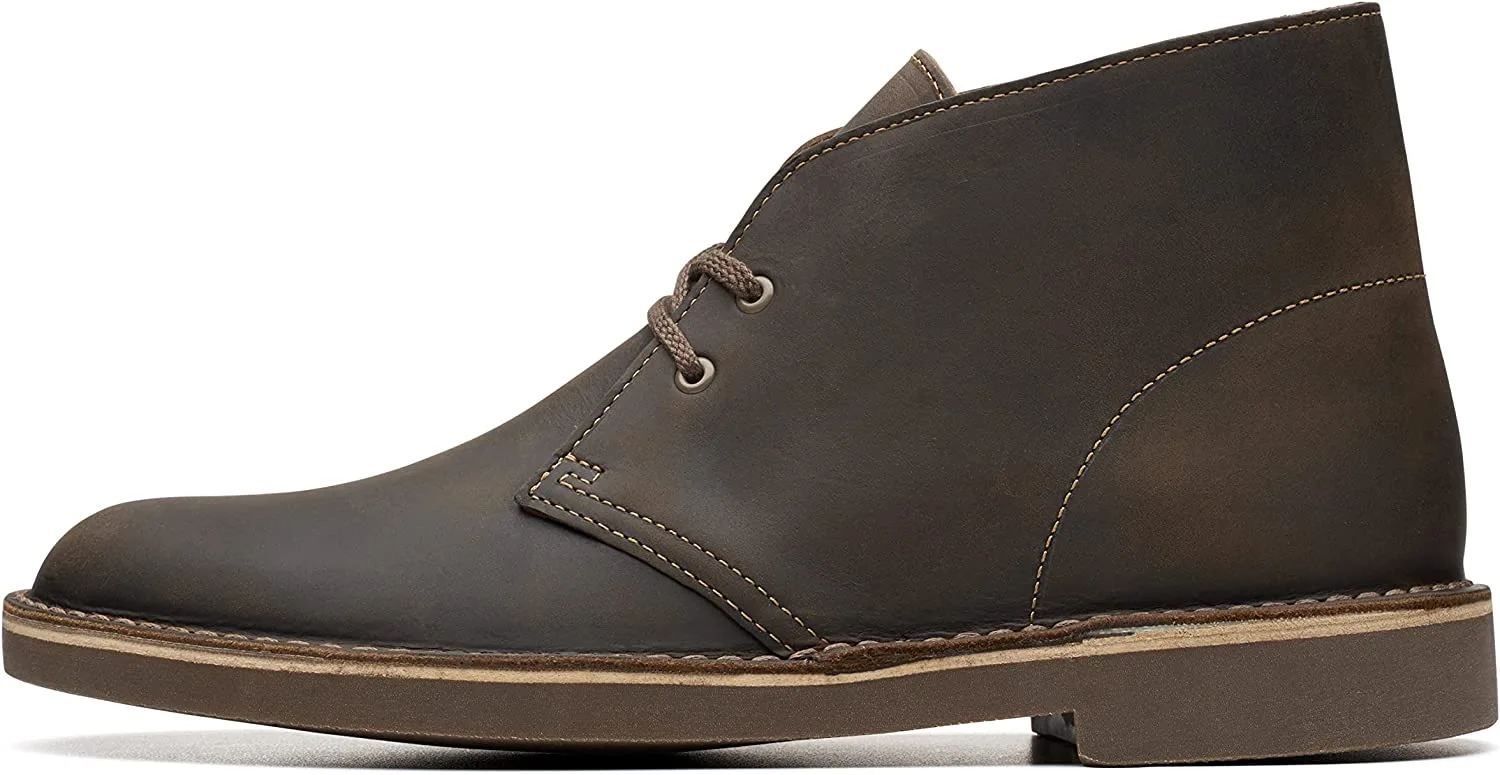
Features
- Imported, 100% Leather With Rubber Sole
- The shaft measures approximately ankle-high
- The platform measures approximately 0.75 inches
- The boot opening measures approximately 10″ around
- Two eyelet lace-up front, Cushioned insole
- Upper material – Suede. Lining material- Leather
If you’re someone who suffers from lower back pain and is looking for a comfortable and supportive shoe, the Clarks Men’s Bushacre 2 Chukka Boot might be the perfect fit for you. Here are some features of this boot that could help alleviate lower back pain:
- Ortholite insole: The Clarks Men’s Bushacre 2 Chukka Boot comes with an Ortholite insole that provides superior cushioning and support to your feet. This feature can help distribute your weight evenly, reduce pressure on your lower back, and provide comfort throughout the day.
- Flexible sole: The flexible rubber sole of the shoe ensures that your feet can move naturally and freely, without causing any strain on your lower back. This feature can help reduce fatigue and discomfort, making the shoe ideal for extended periods of wear.
- Durable leather upper: The Clarks Men’s Bushacre 2 Chukka Boot is made with a durable leather upper that provides long-lasting wear and support. This feature can help stabilize your feet and ankles, reducing the risk of strains and injuries that could contribute to lower back pain.
- Minimalistic design: The minimalistic design of the boot makes it versatile and suitable for various occasions. This feature means you can wear it to work, on a casual day out, or for a night out without having to switch shoes. This feature also makes the boot more practical, reducing the likelihood of carrying multiple pairs of shoes, which could contribute to back pain.
- Lace-up closure: The lace-up closure of the boot ensures a snug fit, providing support to your feet, and reducing the likelihood of slips and falls, which could result in back injuries.
Overall, the Clarks Men’s Bushacre 2 Chukka Boot is an excellent choice for anyone with lower back pain. Its cushioned Ortholite insole, flexible sole, durable leather upper, minimalistic design, and lace-up closure all work together to provide a comfortable and supportive shoe that can help alleviate lower back pain.
6. Bruno Marc Men’s Loafers | Top-rated Dress Shoes For Degenerative Disk Disease
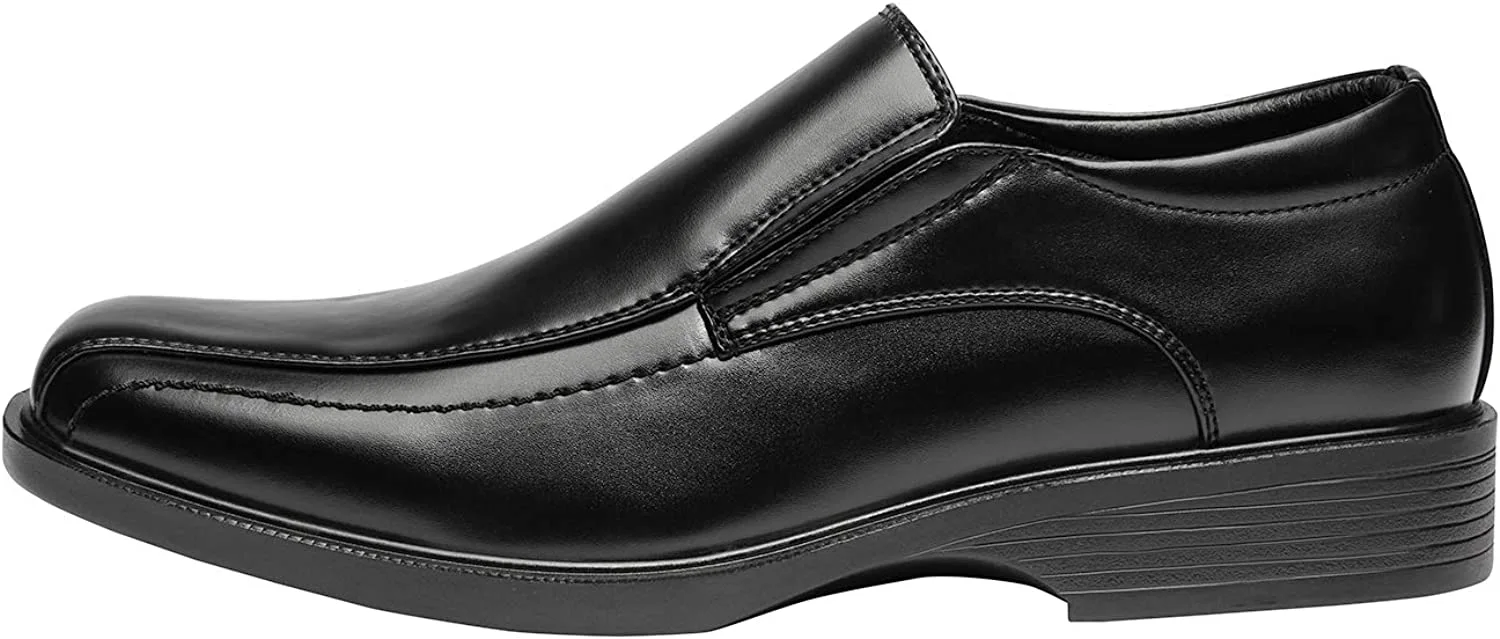
Features
- Heel measures approximately 1inches”
- Soft synthetic leather upper features a square toe
- Easy slip-on style with dual side goring for a comfortable fit
- Breathable leather linings and leather-covered cushioned latex footbed for all-day comfort
- Dress shoes with durable TPR outsole designed in USA
When You’re looking for a versatile dress shoe that is comfortable and supportive for your lower back or disc degenerative disease, the Bruno Marc Leather Lined Dress Shoes might be an excellent choice. Here are some features of this shoe that could help alleviate lower back pain:
- Cushioned insole: The Bruno Marc Leather Lined Dress Shoes come with a cushioned insole that provides superior comfort and support for your feet. This feature can help distribute your weight evenly, reduce pressure on your lower back, and provide comfort throughout the day.
- Durable leather upper: The shoe is made with a durable leather upper that provides long-lasting wear and support. This feature can help stabilize your feet and ankles, reducing the risk of strains and injuries.
- Slip-on design: The slip-on design of the shoe ensures that you can easily put it on and take it off without having to bend over or tie laces.
- Versatile style: The versatile style of the Bruno Marc Leather Lined Dress Shoes makes it suitable for various occasions. Whether you’re going to work, a formal event, or a night out, this shoe can complement any outfit, eliminating the need to carry multiple pairs of shoes.
- Convertible design: The shoe comes with a convertible heel that can be folded down, allowing you to wear it as a slip-on shoe or a traditional dress shoe. This feature makes it more practical and versatile, reducing the likelihood of carrying multiple pairs of shoes.
Overall, the Bruno Marc Leather Lined Dress Shoes is an excellent choice for anyone with lower back pain and herniated or degenerative disc. Its cushioned insole, durable leather upper, slip-on design, versatile style, and convertible design all work together to provide a comfortable and supportive shoe that can help alleviate lower back pain.
Best Women’s Shoes for Degenerative Disk Disease
Here we concluded a list of top women’s shoes for back or disc illness.
- Hoka One One Bondi 7 | Women’s Orthopedic Shoes
- Asics Gel-Kayano 26 | The Best Running Shoes
- Brooks Addiction Walker 2 | Best Walking Shoes
- Merrell Siren Sport Q2 | Women’s Hiking Shoes
- Dr. Scholl’s Webster | Dress Shoes for Nurses
- Dr. Martens 2976 Leonore Chelsea | Women’s Dress Shoes For DDD
Let’s review the top shoes one by one for women’s struggling with lower back or knee pain.
1. Hoka One One Bondi 7 | Best Women’s Walking Shoes for Disc Degenerative Disease
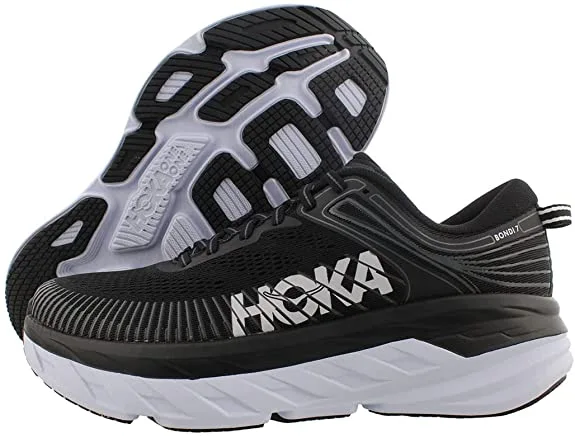
Features
- 100% Synthetic
- Rubber sole
- Breathable open-engineered textile mesh upper with seamless synthetic overlays
- Breathable textile lining
- Removable textile-lined, foam-padded insole
The Women’s version of Hoka Women’s Bondi 7 has the same artillery which the male version is packed with. The EVA midsole and META-ROCKER technology successfully provide you with excellent comfort and support again for back pain.
The responsive cushioning of the shoes is so admirable that even the critics of the shoe have no choice except to praise it. The cushioning absorbs the shock wonderfully facilitating maximum energy return and allowing Hoka Women’s Bondi One One 7 to be ideal for those suffering from disc degenerative disease.
One of the great benefits of the shoe is that they are fit for multipurpose uses you can run, walk, hike, or just wear them throughout the day without any difficulty even with back pain.
Again the lower side of the shoes is their look and they aren’t recommended for people with high arches. Although the shoes are on the expensive side, the quality, comfort, and cushioning justify the price.
2. Asics Gel-Kayano 26 | The Best Women’s Running Shoes for Lower Back Pain
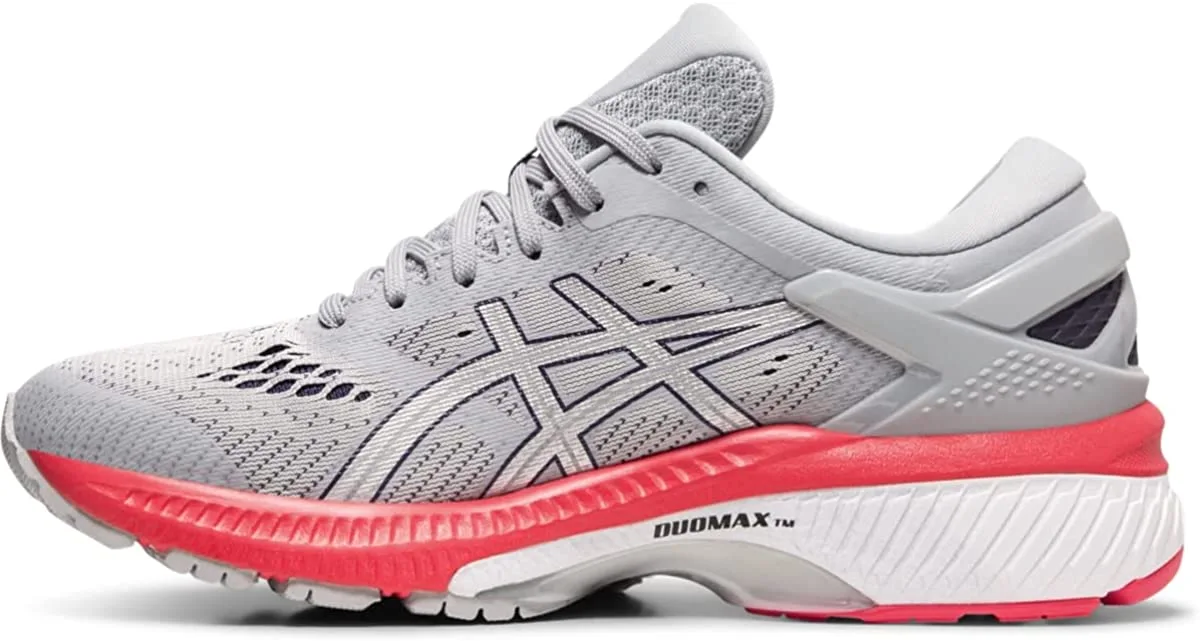
Features
- SpevaFoam 45 Lasting
- I.G.S (Impact Guidance System) Technology
- FlyteFoam Lyte and Propel Technology
- Dynamic DuoMax Support System
Another Asics shoe on the list is Asics Women’s Gel-Kayano 26. The shoes boast DUOMAD midsole and IGC technologies that offer you very smooth overpronation reducing both flat feet and bunions and highly enhanced gait from heel strike to take-off.
These eye-catching shoes feature FLYTEFOAM LYTE TECHNOLOGY and Super Comfy Gel that is made to provide you with extraordinary comfort to alleviate lower back pain.
The wide toe-box has enough space for your toe making them perfect for running especially for wide feet. On the outsole, you’ll get insane traction that will provide you with a firm grip making the shoes equally good for workouts and walking.
The JACQUARD MESH UPPER in the shoe looks breathable but unfortunately, it fails to do its job. Apart from that, the shoes run small in size and have minimal arch support which is not so good for people with a high arch.
3. Brooks Addiction Walker 2 | Best Women’s Walking Shoes for Herniated Disc
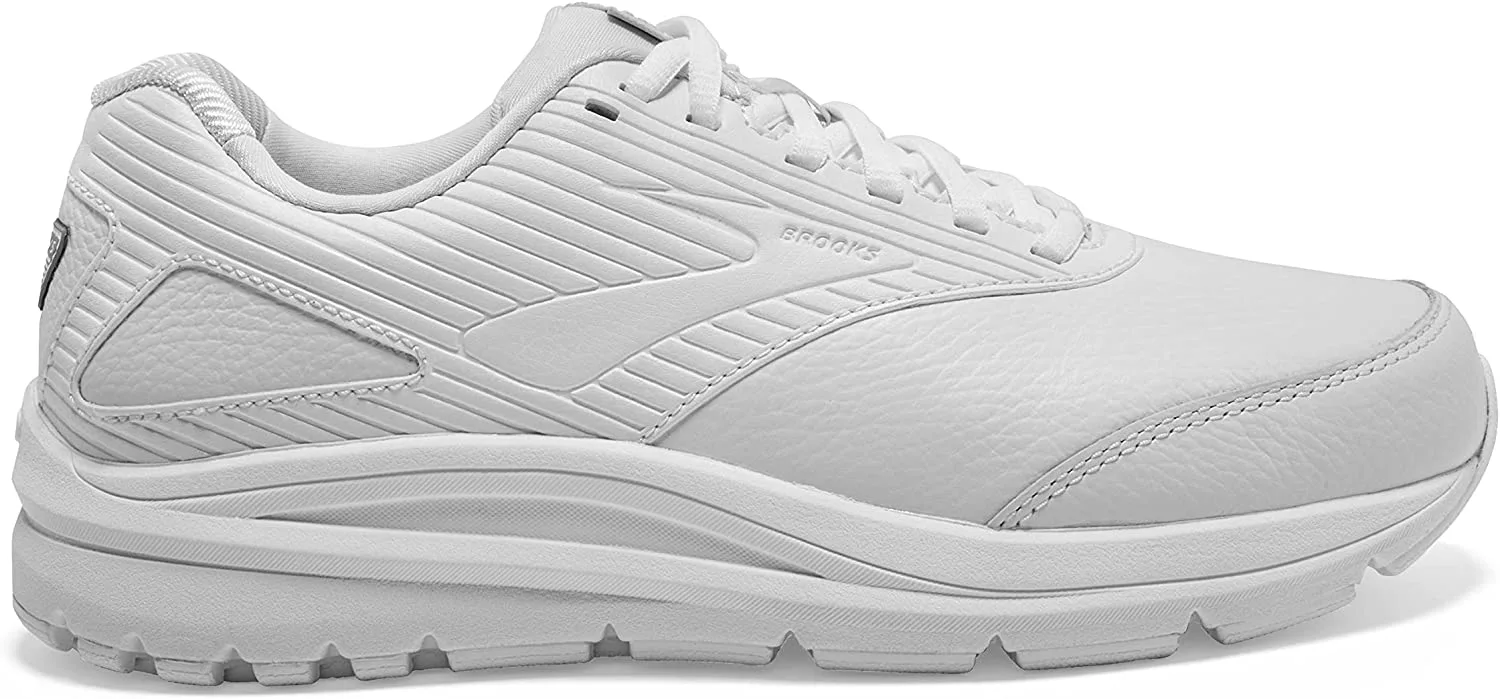
Brooks Women’s Addiction Walker 2 reserved its place in our list as the Best Walking Shoes for Women. The shoe has effectively reduced the pain in the ankle, knees, hip, and back as reported by many users.
This medical arsenal is exceptionally comfy, and supportive and works well for persons suffering from plantar fasciitis and degenerative disk disease. The genuine leather is aesthetically pretty and durable.
Apart from these, the shoes have BioMogo DNA cushioning and Progressive DNA Rollbar for excellent shock absorption, natural gait, and rapid movement.
The shoes look slightly larger and feel quite heavy which can be considered as their limitations.
4. Merrell Siren Sport Q2 | Best Women’s Hiking Shoes for Back Pain Sufferers
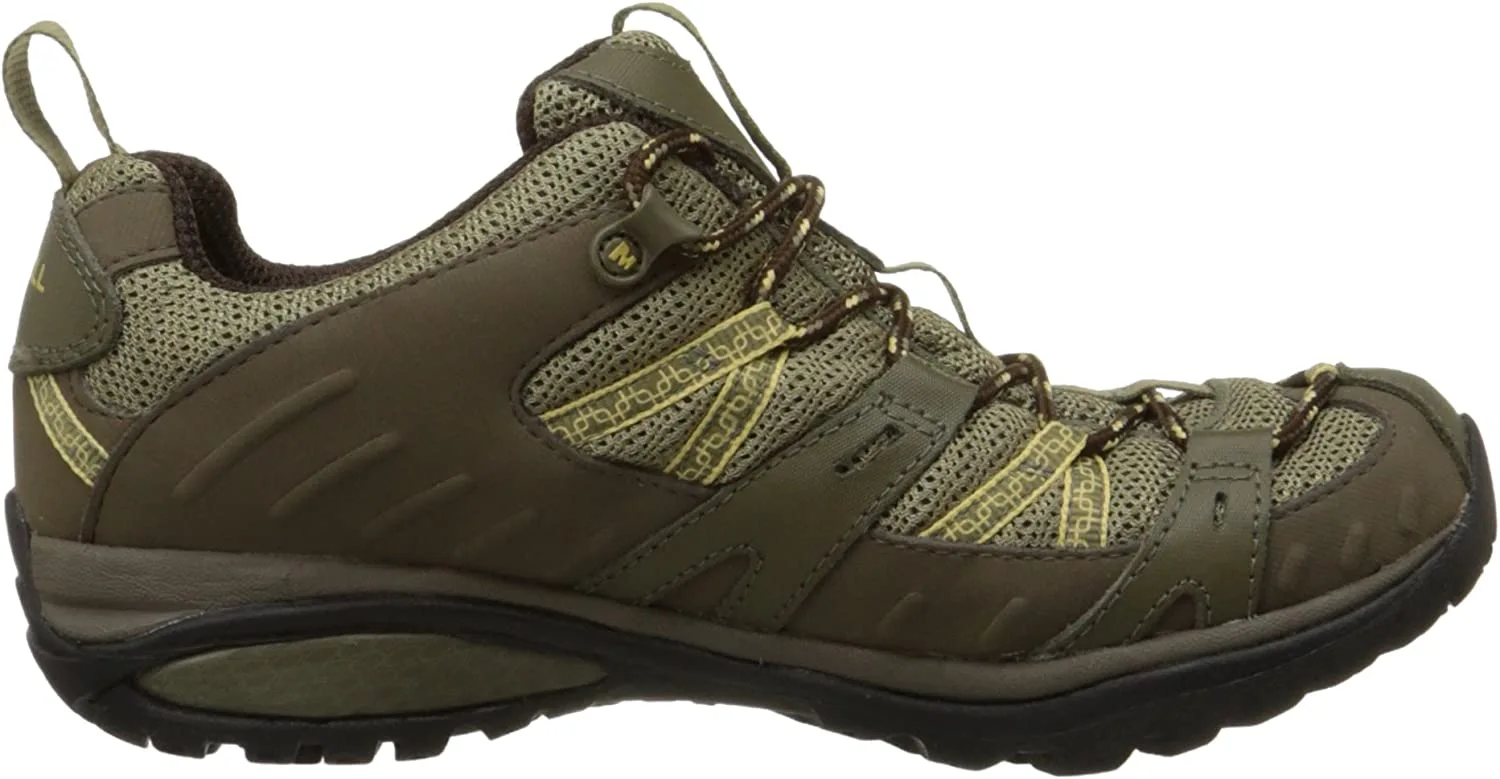
Sub Title
- 100% Leather/Textile and Synthetic sole
- Low-cut hiking shoe featuring patterned webbing overlays and ghillie lacing
- Merrell Omni-Fit lacing system
- Breathable mesh lining treated with Aegis
- Ortholite anatomical footbed
- Merrell air cushion in the heel absorbs shock
Experience out-of-the-box comfort with these sturdy hiking shoes for women. Made of durable genuine leather and Merrell Siren Sport Q2 Hiking shoes deliver powerful performance and comfort.
The engineered leather and mesh upper make the shoes both durable and comfortable. Move freely your toe in all directions since it has a roomy toe box that gives ample space to your to adjust itself.
Thanks to the supportive footbed that acts as a cradle for your foot. But this might not work for you if your feet are too narrow.
The VIBRAM high-performance rubber sole performs well giving you a firm grip on the rough terrain and taking the stability to the next level.
Thanks to the High-performance rubber sole that offers great durability, stability, and slip resistance features. Being lightweight they can be worn on long trails.
The shoes boast AIR CUSHION
Targeted heel cushioning to provide you with superior cushioning but unfortunately, this doesn’t meet your expectations and will hurt the wonky feet.
5. Dr. Scholl’s Women’s Webster | Best Shoes for Nurses With Back Pain
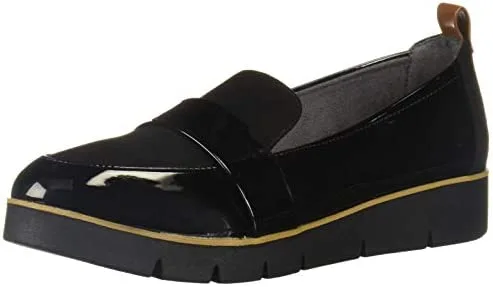
Features
- 100% Synthetic, Imported, Synthetic sole
- Shaft measures approximately low-top from arch
- Heel measures approximately 1.26″
- Materials: faux leather with soft, feel-good linings
- Fit: slip-on fit with faux leather back pull tab
- Feels: comfort insole technology with anatomical cushioning, comfort
As a working lady like a nurse, you know just how important it is to have comfortable shoes that can keep up with your long shifts. And when it comes to style, why settle for anything less than edgy and on-trend? That’s where this loafer comes in.
With its patent and microsuede upper and almond toe, this shoe is both stylish and professional. The strap accent adds a touch of uniqueness that is sure to catch the eye of your coworkers and patients alike.
But what really makes this loafer stand out is its comfort features. The slip-on fit with faux leather back pull tab makes it easy to get on and off, while the Be Energized insole provides all-day comfort, cushioning, and shock absorption. This means you can say goodbye to foot pressure and fatigue, and hello to a more comfortable day on your feet.
The lug sole is both flexible and durable, so you can wear these shoes day after day without worrying about wear and tear. And with a 1-inch platform, you’ll get a little extra height without sacrificing comfort.
So if you’re looking for a shoe that can keep up with the demands of nursing while still looking great, look no further than this loafer. With its unbeatable combination of style and comfort, it’s the perfect choice for any working woman on the go.
6. Dr. Martens 2976 Leonore Chelsea | Best Women’s Dress Shoes For Disc Degenerative Disease
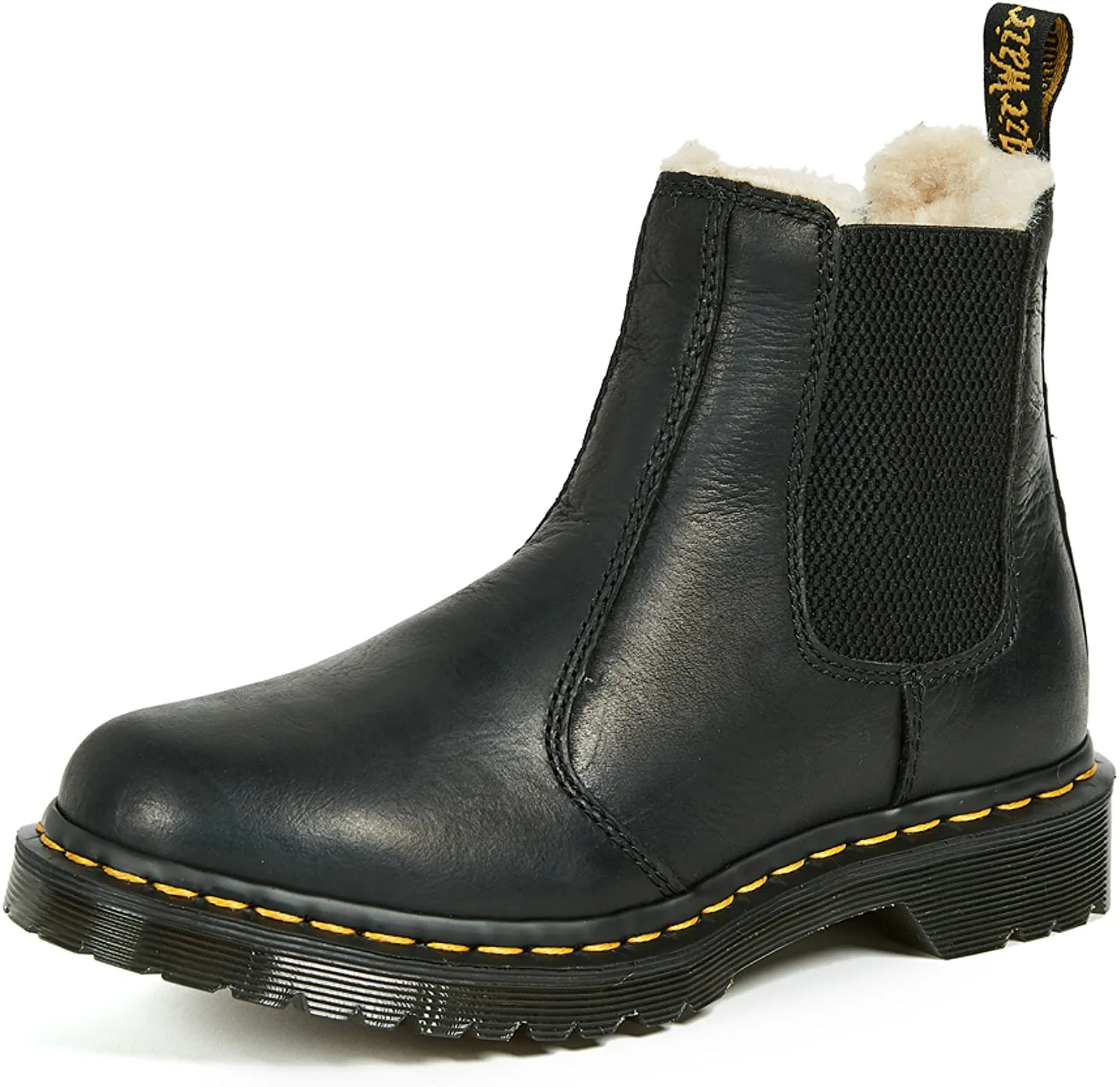
Features
- 100% Leather, Imported, and Synthetic sole
- The iconic Dr. Martens air-cushioned sole
- This boot is Goodyear-welted
- Lined with warm faux fur
- Retains essential Doc DNA
If you suffer from disc degenerative disease or lower back pain, finding a comfortable and stylish shoe can be a real challenge. That’s why the Dr. Martens Women’s 2976 Leonore Chelsea boot is the perfect choice for anyone looking for a comfortable and supportive dress shoe.
Made from 100% leather with a warm faux fur lining, this boot is perfect for those cold winter months. The elastic ankle gusset makes it easy to slip on and off, while the iconic Dr. Martens air-cushioned sole provides all-day comfort and support.
What really sets this boot apart, however, is its construction. The upper and sole are sewn together in a heat-sealed z-welt stitch, making it extremely durable and long-lasting.
The boot also features yellow stitching, grooved sides, and a heel loop, which retain the essential Doc DNA that the brand is known for.
The 1-inch heel and 0.75-inch platform provide just the right amount of lift without sacrificing comfort, while the good abrasion and slip resistance make this boot ideal for all kinds of weather conditions.
Overall, if you’re looking for a dress shoe that is both stylish and supportive, the Dr. Martens Women’s 2976 Leonore Chelsea boot is a great choice.
With its unique combination of comfort and durability, it’s the perfect shoe for anyone with disc degenerative disease who wants to look and feel their best.
Top Unisex Slip-on or Sandals For Back Pain Sufferers
We included some unisex for casual or home use.
1. Crocs Men-Women Classic Clogs | Unisex Slip-On Shoes for Degenerative Disk Disease
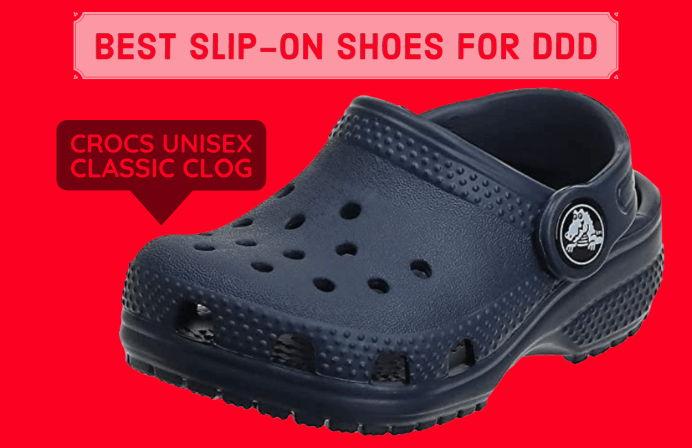
Crocs Men-Women Classic Clogs have almost everything which you desire to have for your flimsy feet which makes them the Best Unisex Slip-on Shoes. Strolling on the beach with your toddler would be an amazing experience with these comfy crocodiles. 🙂
Boasting the lightweight Iconic Crocs Comfort Ventilation ports the clogs improve breathability and help to cast off water and debris quickly. The vents in the upper don’t allow your feet to sweat. It’s really simple to put them on and off, the additional pivoting heel straps give you a more secure fit.
“They are also ugly but they are so ugly that they are cute”, reported a customer. Try them with any outfit and you’ll find that they match. But for some, they are like Clown Shoes.
Some gripes are— they SNUG at the midfoot and the material is quite hard. Another problem is that they run ½ or 1 size larger. The inside of the strap has raised letters that keep rubbing the backs of ankles which hurts and irritates.
2. Vionic Wave Orthotic Sandal | Unisex Slip-On Sandal for Degenerative Disk Disease
Though Flip-Flops aren’t considered as good for your feet these are the exceptions. Having a Podiatrist-Designed Footbed with Vio-Motion Support that includes Three-Zone Comfort has enabled them to receive the APMA (American Podiatric Medical Association) Seal of Acceptance.
The BIOMECHANICALLY Designed EVA footbed hugs your arches and provides phenomenal support to your feet for all-day comfort.
The Nylon Webbing Upper is waterproof allowing you to wear them in wet conditions too. Thanks to the sturdy Rubber Outsole which gives you a feel as if you are walking barefoot.
The sandals work exceptionally well for people with high arches but people with overpronation may not find them good.
They need some days to break in according to your foot and might hurt you for that duration. They are also heavier than the usual sandals.
What is Disk Degenerative Disease (DDD)?
Degenerative disc disease (DDD) is a common condition that affects the spine. It is characterized by the breakdown of intervertebral discs, which act as shock absorbers between the vertebrae in the spine.
DDD is a progressive condition that can lead to chronic pain, stiffness, and loss of mobility in the affected area.
Construction of Discs
The intervertebral discs are made up of two main components: the annulus fibrosus and the nucleus pulposus.
The annulus fibrosus is the outer layer of the disc, made up of tough fibers that provide structure and support. The nucleus pulposus is the soft, gel-like center of the disc that absorbs shock and allows for flexibility and movement.
Causes of Disc Degeneration
As we age, the intervertebral discs naturally begin to break down and lose their ability to absorb shock. This is due to a combination of factors, including wear and tear, loss of hydration, and a decrease in the production of key proteins in the disc.
In some cases, this breakdown can cause the disc to herniate or bulge, putting pressure on nearby nerves and causing pain and discomfort.
There are several risk factors that can increase the likelihood of developing DDD. These include:
- Aging: DDD is more common in older adults, as the discs naturally degenerate over time.
- Genetics: Some people may be more prone to developing DDD due to genetic factors.
- Obesity: Excess weight can put additional stress on the spine, leading to increased wear and tear on the discs.
- Smoking: Smoking can reduce blood flow to the discs, making it more difficult for them to receive nutrients and heal from damage.
Treatment for DDD typically focuses on managing symptoms and preventing further degeneration of the discs. This may include a combination of pain medication, physical therapy, and lifestyle changes such as weight loss and smoking cessation. In severe cases, surgery may be necessary to remove damaged portions of the disc or fuse adjacent vertebrae together.
While DDD can be a painful and debilitating condition, there are many effective treatments available to help manage symptoms and improve quality of life. If you are experiencing chronic back pain or other symptoms of DDD, it is important to consult with a healthcare professional to determine the best course of treatment for your individual needs.
Frequently Asked Questions:
What helps slow degenerative disc disease?
To slow the progression of degenerative disc disease, maintain a healthy weight, avoid smoking, practice proper posture and ergonomics, exercise regularly, stay hydrated, consume a balanced diet, and wear supportive shoes. Consult with a healthcare professional for personalized advice.
What should you not do with degenerative disc disease?
With degenerative disc disease, it is important to avoid activities that put excessive strain on the spine, such as heavy lifting, twisting, and repetitive bending. Sitting or standing for extended periods can also exacerbate symptoms. It is important to consult with a healthcare professional to determine appropriate activity levels and restrictions.
What is good for degenerative disc disease?
To manage symptoms of degenerative disc disease, low-impact exercises such as walking, swimming, or yoga can help to improve flexibility and reduce pain. Physical therapy, chiropractic care, and acupuncture may also provide relief. Pain medication and surgery may be necessary in severe cases.
How can I strengthen my lower back with degenerative disc disease?
With degenerative disc disease, it is important to focus on exercises that strengthen the surrounding muscles without putting undue strain on the spine. Low-impact exercises such as bridges, wall squats, and partial crunches can help to improve strength and stability in the lower back.
How do you calm degenerative disc disease?
To calm symptoms of degenerative disc disease, low-impact exercise, such as walking, swimming, and yoga, can help to improve flexibility and reduce pain. Heat or cold therapy, massage, and acupuncture may also provide relief. Pain medication and surgery may be necessary in severe cases
Is walking or running good for degenerative disc disease?
Low-impact exercise, such as walking, is generally better than high-impact exercises, such as running, for degenerative disc disease. Walking helps to improve flexibility and reduce pain without putting excessive strain on the spine.
Can disc degeneration be stopped?
While degenerative disc disease is a natural part of aging, there are several things you can do to help slow its progression. However, it is unlikely that degeneration can be stopped completely. Consult with a healthcare professional for personalized advice.
10 Best Exercises For Degenerative Disc Disease
Conclusion: Best Shoes for Degenerative Disc Disease
Time to wrap up now. While considering the best shoes for Degenerative Disc Disease pay special attention to comfort and the aforementioned points.
I hope that you will find the information presented here useful and this will help you to choose the best shoes according to your needs and preferences.
I also hope that the chosen shoes will give you relief from Degenerative Disk Disease. Don’t skip to consult a registered Chiropractor to get the customized list of features that you should look for in the shoes. All the Best for your purchase.
References of our research:
- Mayo Clinic. Degenerative disc disease.
- Cleveland Clinic. Degenerative Disc Disease.
- National Institute of Arthritis and Musculoskeletal and Skin Diseases. Handout on Health: Back Pain.
Thanks! for more useful reviews and information about shoes keep visiting shoespreview.com

